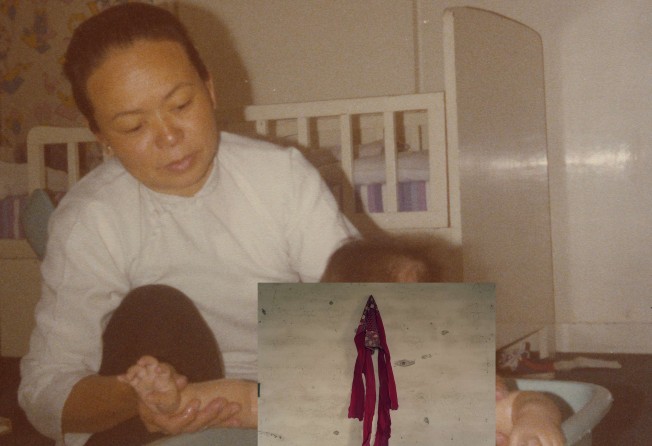
Hong Kong artist’s homage to his selfless amah
She came from poor farming stock in Zhongshan, and chose chastity and the sisterhood of the ‘combed up’ women over arranged marriage. Artist Kurt Tong honours Mak Ngan-yuk’s sacrifice and a dying tradition

Hong Kong-born, England-educated Kurt Tong King-fung has been exploring themes of identity, this city and life among the diaspora. His large-scale exhibition, “The Queen, the Chairman and I” (2009-12), developed as a reminder to his young daughters to appreciate their cultural heritage and identity, has been shown around the world.
As it expanded into a book project, it also, according to the artist, “spoke to the millions of Chinese who have escaped war, famine and communism – or anyone in the world who has gone through migration and displacement”.
One small part of that exhibition featured Mak Ngan-yuk, Tong’s amah, who worked for his family for nearly 40 years. In “Threads of Sisterhood”, his latest solo show, at Lumenvisum, in Shek Kip Mei, Mak takes centre stage and we get to glimpse a little more of her life.
Tong has skillfully created an installation of photographs, drawings and objects that subtly reflects Mak’s quiet and conscientious work for her adopted family and her central role as the main breadwinner for her relatives on the mainland. The dual role of being a “secondary” employee but “pivotal” absent family member continues to exist in Hong Kong, with the city’s legions of female domestic workers.
Now aged 87, Mak was the eldest child of a poor farming family living in Zhongshan, in Guangdong province. She was denied schooling because of her sex and was tasked with caring for her younger siblings and work in the nearby mulberry fields, where silk was produced. She wanted an education and began paying for her own schooling but, after her father found out, she was told she “should be paying for her brothers, instead of wasting it on herself”.
The dual role of being a “secondary” employee but “pivotal” absent family member continues to exist in Hong Kong, with the city’s legions of female domestic workers
As Mak got older, pressure to get married before her younger brothers grew. Not wanting to be forced into an arranged marriage, she decided to become independent and performed a “comb-up ceremony”, tying her hair in a bun as confirmation of her spinsterhood.
The origins of the ceremony date back to the start of the Qing dynasty, when women worked in the mulberry fields and earned good wages from the then-booming silk trade. As a sign of independence before marriage, women would wear their hair in a long braid. As the silk trade declined in the late 19th century, many women sought employment elsewhere in Asia.

The later comb-up ceremony, the viewer is informed, “involved bathing in mulberry leaves and a fellow ‘sister’ would braid their hair. From that day on, they could only wear a light colour tunic and dark trousers. They would take the chastity vow and have no further obligations towards their parents … the combed-up women would look after each other” and in old age some lived together in “sisterhood homes”.
Mak arrived in Hong Kong and worked as an amah for only two families over the next 55 years.
Tong begins the exhibition with the few photographs Mak has of herself – three passport pictures arranged in order of age.
A strong narrative is built around old photographs depicting the Tong family, with Mak seen on the edges, caring for the children. Tong covers these images of himself and his family with framed photographs of Mak’s simple possessions – a telephone covered in a protective cloth, a teacup, a set of double-happiness bowls. These family photographs are no longer of the family, but reworked as a strongly felt homage to Mak’s “hard working, selfless and independent personalities”.

A final wall of photographs of Mak family gatherings and wedding celebrations emphasises the stoic simplicity of the amah’s own life. The final, powerful, recent photograph of Mak standing in her village “symbolises the last generation of comb-up women, hard-working, selfless and independent”.
Kurt Tong’s “Threads of Sisterhood” exhibition will be on display at Lumenvisum, Jockey Club Creative Arts Centre, 30 Pak Tin Street, Shek Kip Mei, until November 27.